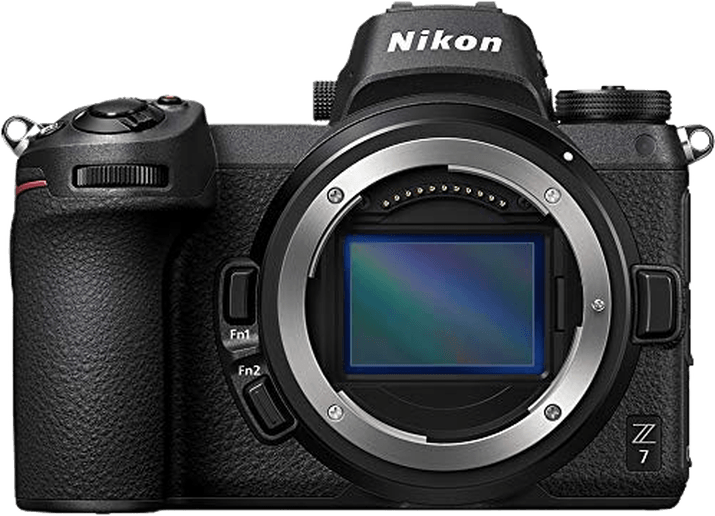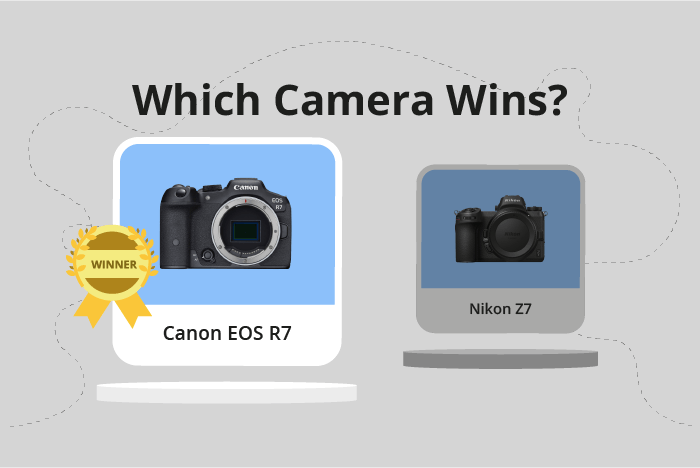Canon EOS R7 vs Nikon Z7 Comparison
Canon EOS R7

Nikon Z7

The Canon EOS R7 edges out the Nikon Z7 with a score of 83/100 compared to 82/100. Both are mirrorless cameras, released in 2022 and 2018, respectively. They share similarities in size, with the EOS R7 measuring 132 x 90 x 92mm and the Z7 at 134 x 101 x 68mm.
The EOS R7 excels with its lighter weight of 612g, making it more comfortable for extended use. Additionally, its launch price of $1500 offers better value compared to the Z7’s $3400 price tag. On the other hand, the Nikon Z7’s slightly larger dimensions might provide a better grip for some users.
Taking these factors into account, the Canon EOS R7 emerges as the winner due to its lighter weight and more affordable price. However, the Nikon Z7 remains a strong contender with its potential for better handling.
Canon EOS R7 vs Nikon Z7 Overview and Optics
The Nikon Z7 outperforms the Canon EOS R7 in optics, scoring 86/100 compared to the Canon’s 82/100. Both cameras share several specifications, such as CMOS sensor type, image stabilization, and their respective lens mounts (Canon RF for the EOS R7 and Nikon Z for the Z7).
The Nikon Z7 excels with its higher megapixel count of 45.7, compared to the Canon EOS R7’s 33 megapixels. This difference allows the Nikon Z7 to capture more detail and produce higher resolution images. Additionally, the Z7 has a full-frame sensor, whereas the Canon EOS R7 has an APS-C sensor. The full-frame sensor contributes to better low-light performance and increased dynamic range. The Z7’s sensor also boasts a higher DXOMARK score of 99, compared to the EOS R7’s 97.
On the other hand, the Canon EOS R7 has a faster shooting speed of 15 frames per second (fps), compared to the Nikon Z7’s 9 fps. This makes the EOS R7 more suitable for capturing fast-moving subjects and action photography.
In terms of optics, the Nikon Z7 emerges as the superior choice due to its higher megapixel count, full-frame sensor, and better DXOMARK score. However, the Canon EOS R7’s faster shooting speed should not be overlooked, as it may be a deciding factor for those who prioritize action photography. Ultimately, the choice between these two cameras depends on the specific needs and preferences of the photographer.
Canon EOS R7 vs Nikon Z7 Video Performance
The Canon EOS R7 outperforms the Nikon Z7 in video capabilities, with a video score of 91/100 compared to the Nikon Z7’s 83/100. Both cameras share common features, such as 4K max video resolution, 3840 x 2160 max video dimensions, and built-in time-lapse functionality.
The Canon EOS R7 excels in its maximum video frame rate, offering 120fps compared to the Nikon Z7’s 60fps. This advantage allows the EOS R7 to capture smoother, more detailed slow-motion footage, making it a better choice for videographers seeking high-quality slow-motion capabilities.
While the Nikon Z7 falls short in frame rate, it still offers impressive video quality with its 4K resolution, 3840 x 2160 video dimensions, and built-in time-lapse functionality. These features make the Nikon Z7 a capable camera for various video applications, although it may not be the preferred choice for those prioritizing slow-motion capabilities.
Comparing the video capabilities of the Canon EOS R7 and the Nikon Z7, the EOS R7 emerges as the superior choice for videographers due to its higher video score and exceptional 120fps frame rate. Although the Nikon Z7 offers similar resolution and time-lapse features, its lower frame rate makes it less ideal for capturing slow-motion footage. Ultimately, the Canon EOS R7’s video capabilities make it a more versatile and powerful choice for videographers.
Canon EOS R7 vs Nikon Z7 Features and Benefits
The Nikon Z7 wins the features comparison with a score of 87/100, while the Canon EOS R7 scores 85/100. Both cameras share several specifications, such as having a touchscreen, flip screen, WiFi, and Bluetooth connectivity, but no GPS.
The Nikon Z7 outperforms the Canon EOS R7 in terms of screen size and resolution. It has a larger 3.2-inch screen, compared to the 3-inch screen of the Canon EOS R7. The Z7 also boasts a higher screen resolution of 2,100,000 dots, providing a clearer and more detailed display than the 1,620,000 dots of the EOS R7. These advantages contribute to the Nikon Z7’s superior feature score.
On the other hand, the Canon EOS R7 does not surpass the Nikon Z7 in any specific feature. However, it still maintains a high feature score, indicating that it is a capable camera with a competitive set of features.
Taking all these points into consideration, the Nikon Z7 proves to be the better camera in terms of features, thanks to its larger screen and higher screen resolution. The Canon EOS R7 is still a strong contender, but it does not offer any significant advantages over the Nikon Z7. Prospective buyers should consider these differences when deciding which camera best suits their needs and preferences.
Canon EOS R7 vs Nikon Z7 Storage and Battery
The Canon EOS R7 outperforms the Nikon Z7 in storage and battery with a score of 79/100, compared to the Nikon Z7’s 35/100. Both cameras have USB charging capabilities, but the similarities end there.
The Canon EOS R7 boasts two memory card slots, accepting SD, SDHC, and SDXC cards, all UHS-II compatible. This versatility and extra slot make it superior in storage capacity. Additionally, the Canon EOS R7 offers an impressive battery life of 660 shots with its LP-E6NH battery type.
On the other hand, the Nikon Z7 falls behind with only one memory card slot, limited to XQD cards. Moreover, its EN-EL15b battery type yields a significantly lower battery life of 330 shots, half of what the Canon EOS R7 provides.
Despite its lower score, the Nikon Z7 still offers a decent battery life and storage capacity for casual photographers. However, the Canon EOS R7 clearly excels in these aspects, making it a better choice for those who prioritize storage and battery performance in their camera selection.
Canon EOS R7 vs Nikon Z7 – Our Verdict
Are you still undecided about which camera is right for you? Have a look at these popular comparisons that feature the Canon EOS R7 or the Nikon Z7:

